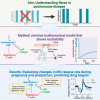chillier
Senior Member (Voting Rights)
https://www.sciencedirect.com/science/article/pii/S2589004223021612
Summary:
Many autoimmune disorders exhibit flares in which symptoms erupt and then decline, as exemplified by multiple sclerosis (MS) in its relapsing-remitting form. Existing mathematical models of autoimmune flares often assume regular oscillations, failing to capture the stochastic and non-periodic nature of flare-ups. We suggest that autoimmune flares are driven by excitable dynamics triggered by stochastic events auch as stress, infection and other factors. Our minimal model, involving autoreactive and regulatory T-cells, demonstrates this concept. Autoimmune response initiates antigen-induced expansion through positive feedback, while regulatory cells counter the autoreactive cells through negative feedback. The model explains the decrease in MS relapses during pregnancy and the subsequent surge postpartum, based on lymphocyte dynamics. Additionally, it identifies potential therapeutic targets, predicting significant reduction in relapse rate from mild adjustments of regulatory T cell activity or production. These findings indicate that excitable dynamics may underlie flare-ups across various autoimmune disorders, potentially informing treatment strategies.
Graphical abstract:

Summary:
Many autoimmune disorders exhibit flares in which symptoms erupt and then decline, as exemplified by multiple sclerosis (MS) in its relapsing-remitting form. Existing mathematical models of autoimmune flares often assume regular oscillations, failing to capture the stochastic and non-periodic nature of flare-ups. We suggest that autoimmune flares are driven by excitable dynamics triggered by stochastic events auch as stress, infection and other factors. Our minimal model, involving autoreactive and regulatory T-cells, demonstrates this concept. Autoimmune response initiates antigen-induced expansion through positive feedback, while regulatory cells counter the autoreactive cells through negative feedback. The model explains the decrease in MS relapses during pregnancy and the subsequent surge postpartum, based on lymphocyte dynamics. Additionally, it identifies potential therapeutic targets, predicting significant reduction in relapse rate from mild adjustments of regulatory T cell activity or production. These findings indicate that excitable dynamics may underlie flare-ups across various autoimmune disorders, potentially informing treatment strategies.
Graphical abstract:

